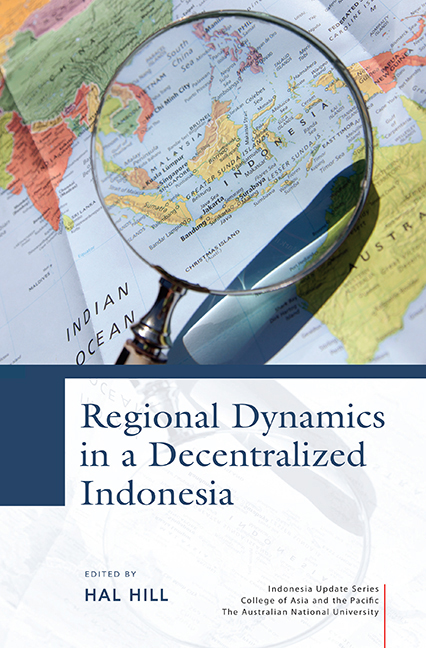Book contents
- Frontmatter
- Dedication
- Contents
- Tables
- Figures
- Contributors
- Acknowledgments
- Glossary
- Map of Indonesia
- 1 An introduction to the issues
- PART 1 HISTORICAL, ECONOMIC, POLITICAL AND SOCIAL PATTERNS
- PART 2 DECENTRALIZATION AND GOVERNANCE
- PART 3 LOCAL-LEVEL PERSPECTIVES
- 10 Dilemmas of participation: the National Community Empowerment Program
- 11 Governing fragile ecologies: a perspective on forest and land-based development in the regions
- 12 Explaining regional heterogeneity of poverty: evidence from a decentralized Indonesia
- PART 4 MIGRATION, CITIES AND CONNECTIVITY
- PART 5 CHALLENGES FOR INDONESIA'S PERIPHERY
- Author index
- Subject index
- INDONESIA UPDATE SERIES
12 - Explaining regional heterogeneity of poverty: evidence from a decentralized Indonesia
from PART 3 - LOCAL-LEVEL PERSPECTIVES
Published online by Cambridge University Press: 21 October 2015
- Frontmatter
- Dedication
- Contents
- Tables
- Figures
- Contributors
- Acknowledgments
- Glossary
- Map of Indonesia
- 1 An introduction to the issues
- PART 1 HISTORICAL, ECONOMIC, POLITICAL AND SOCIAL PATTERNS
- PART 2 DECENTRALIZATION AND GOVERNANCE
- PART 3 LOCAL-LEVEL PERSPECTIVES
- 10 Dilemmas of participation: the National Community Empowerment Program
- 11 Governing fragile ecologies: a perspective on forest and land-based development in the regions
- 12 Explaining regional heterogeneity of poverty: evidence from a decentralized Indonesia
- PART 4 MIGRATION, CITIES AND CONNECTIVITY
- PART 5 CHALLENGES FOR INDONESIA'S PERIPHERY
- Author index
- Subject index
- INDONESIA UPDATE SERIES
Summary
INTRODUCTION
Over the past decade Indonesia has made significant progress in reducing poverty. According to official statistics produced by the national statistics agency (Badan Pusat Statistik, BPS), the poverty rate fell from 23.4 per cent in 1999 to 11.4 per cent in 2013. Viewed from any angle, this is a tremendous achievement. However, as demonstrated also by Amri Ilmma and Matthew Wai-Poi in Chapter 5 of this volume, Indonesia's success at the national level masks the existence of substantial regional differences. This chapter focuses on this regional heterogeneity in poverty indicators. It relates district performance in reducing poverty to characteristics of the decentralization program implemented in Indonesia since 2001.
We argue that the system of governance for managing Indonesia's ‘big bang’ decentralization lacks key institutional requirements, notably adequate performance measures and an effective framework of constraints, as reflected in the shortcomings in the system of controls for central government oversight of local governments (World Bank 2006). Moreover, the division of responsibilities between the different levels of government is unclear, clouding the lines of accountability required to improve service delivery. An additional challenge stems from the uniform implementation of decentralization regardless of regional differences. This is a problem in a country as diverse as Indonesia, where each region differs in local government capacity and available resources. All these factors have undoubtedly had an effect not only on the implementation of the national poverty reduction strategy, but also on the development of local poverty reduction initiatives.
A review of experiences in 19 countries conducted by the OECD Development Centre finds that decentralization has led to improvements in poverty reduction in only one-third of cases (Jütting, Corsi and Stockmayer 2005). The authors argue that lower middle-income countries that have literacy rates above 80 per cent, and whose political processes are relatively open, are more likely to experience decreases in poverty following the adoption of decentralization measures. Overall, they conclude that decentralization is more likely to have a positive impact on poverty if there is an adequate commitment by the central government to the decentralization process, if the actors involved have the requisite (financial and technical) capacity, and if checks and balances are established at the local level to prevent rent seeking and corruption.
- Type
- Chapter
- Information
- Regional Dynamics in a Decentralized Indonesia , pp. 285 - 314Publisher: ISEAS–Yusof Ishak InstitutePrint publication year: 2014

